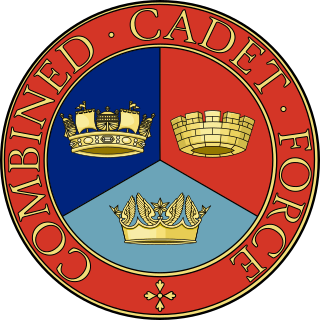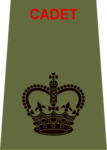Ranks
Ranks in the ACF follow the pattern of those in the British Army.
Cadet ranks
As well as learning new skills by working through the APC syllabus, experienced cadets can be awarded a rank. As the Army allows its soldiers to take on responsibility and leadership as Non-commissioned Officers or NCOs, so too does the ACF.
Cadet NCOs wear the issued cadet rank slides, pictured above. [3] The titles of some ranks may vary as cadet detachments are affiliated to Army regiments and adopt their terminology. There is usually only one Cadet RSM per county.
Although promotion is based on merit rather than progression through the APC syllabus, the following criteria must be met before a cadet is eligible for promotion: [4]
- Cadet Lance Corporal - Passed APC 1 Star
- Cadet Corporal - Passed APC 2 Star
- Cadet Sergeant - Passed APC 3 Star
- Cadet Staff/Colour Sergeant - Passed APC 4 Star
- Cadet Sergeant Major/Company Sergeant Major - Passed APC 4 Star
- Cadet Regimental Sergeant Major - Master Cadet [5]
In some instances, cadets that do not meet the requirements for these ranks can be promoted with the agreement of the ACF Cadet Commandant. [4]
CFAV ranks
The adults who are employed to help run the ACF are collectively known as Cadet Force Adult Volunteers(CFAVs). There are two different kinds of CFAVs, Non-commissioned Officers and Commissioned Officers. As in the Regular Army and Army Reserves, Commissioned Officers out-rank NCOs. The role of the CFAV NCO is to instruct Cadets, the role of the CFAV Officer is to instruct Cadets and command CFAV NCOs.
NCOs
NCO CFAVs wear the badges of rank as worn by Army NCOs [3] with the addition of the letters ACF under the badge.
Officers
Commissioned officers within the ACF wear the same rank slides as British Army officers; however, the letters ACF appear under the insignia. The colours and style of the rank slides mirror the affiliated regiment's.

Military ranks are a system of hierarchical relationships, within armed forces, police, intelligence agencies or other institutions organized along military lines. The military rank system defines dominance, authority, and responsibility in a military hierarchy. It incorporates the principles of exercising power and authority into the military chain of command—the succession of commanders superior to subordinates through which command is exercised. The military chain of command constructs an important component for organized collective action.

A non-commissioned officer (NCO) is a military officer who does not hold a commission. Non-commissioned officers usually earn their position of authority by promotion through the enlisted ranks. In contrast, commissioned officers usually enter directly from a military academy, officer training corps (OTC) or reserve officer training corps (ROTC), or officer candidate school (OCS) or officer training school (OTS), after receiving a post-secondary degree.
Sergeant is a rank in use by the armed forces of many countries. It is also a police rank in some police services. The alternative spelling, serjeant, is used in The Rifles and other units that draw their heritage from the British light infantry. Its origin is the Latin serviens, 'one who serves', through the Old French term serjant.
Corporal is a military rank in use by the armed forces of many countries. It is also a police rank in some police services. The rank is usually the lowest ranking non-commissioned officer. In some militaries, the rank of corporal nominally corresponds to commanding a section or squad of soldiers.
Staff sergeant is a rank of non-commissioned officer used in the armed forces of many countries. It is also a police rank in some police services.
A master sergeant is the military rank for a senior non-commissioned officer in the armed forces of some countries.
Sergeant major is a senior non-commissioned rank or appointment in many militaries around the world.
Lance corporal is a military rank, used by many English-speaking armed forces worldwide, and also by some police forces and other uniformed organisations. It is below the rank of corporal.

The Combined Cadet Force (CCF) is a youth organisation in the United Kingdom, sponsored by the Ministry of Defence (MOD), which operates in schools, sub divided into Royal Navy, Royal Marines, Army and Royal Air Force sections. Its aim is to "provide a disciplined organisation in a school so that pupils may develop powers of leadership by means of training to promote the qualities of responsibility, self reliance, resourcefulness, endurance and perseverance".

The Army Cadet Force (ACF), generally shortened to Army Cadets, is a national youth organisation sponsored by the United Kingdom's Ministry of Defence and the British Army. Along with the Sea Cadet Corps and the Air Training Corps, the ACF make up the Community Cadet Forces. It is a separate organisation from the Combined Cadet Force which provides similar training within principally private schools.

Colour sergeant is a rank of non-commissioned officer found in several armies and marine corps.
A cadet is a student or trainee, and is typically used in military settings to denote an individual undergoing training to become commissioned officers. Several civilian organisations, including civil aviation groups, maritime organisations, and police services, also designate their trainees as cadets.
The Military ranks of Finland are the military insignia used by the Finnish Defence Forces. The ranks incorporates features from Swedish, German, and Russian armed forces. In addition, the system has some typically Finnish characteristics that are mostly due to the personnel structure of the Finnish Defence Forces. The ranks have official names in Finnish and Swedish languages and official English translations. The Swedish forms are used in all Swedish-languages communications in Finland, e.g. in Swedish-speaking units of Finnish Defence Force. The system of ranks in the Swedish Armed Forces is slightly different.

The Cayman Islands Cadet Corps (CICC) is a youth organisation in the Cayman Islands for male and female secondary school students between age 12 and 17. It was established in March 2002.

There are eleven disused railway stations on the Exeter to Plymouth line between Exeter St Davids and Plymouth Millbay in Devon, England. At eight of these there are visible remains.
Royal Marines Cadets (SCC) are part of the Sea Cadets, a United Kingdom uniformed youth organization was formed in 1955 by the then Commandant General Royal Marines – General Sir Campbell Richard Hardy, KCB, CBE, DSO & Bar. The Royal Marines Cadets of the SCC specialise in activities such as orienteering, fieldcraft, and weapon handling.

A warrant officer (WO) in the British Armed Forces is a member of the highest-ranking group of non-commissioned ranks, holding the King's Warrant, which is signed by the Secretary of State for Defence.
The following table displays the ranks of the Community Cadet Forces, the Combined Cadet Force, the Volunteer Cadet Corps, and the Girls Venture Corps Air Cadets. This table is based on equivalent Rank Structures within the Cadet Forces as detailed in regulations of the SCC, RMC, and the Air Cadets.





















